With our easy gluten free sourdough starter, this Gluten Free Sourdough Bread is so perfect, you'll want to make it every single day!
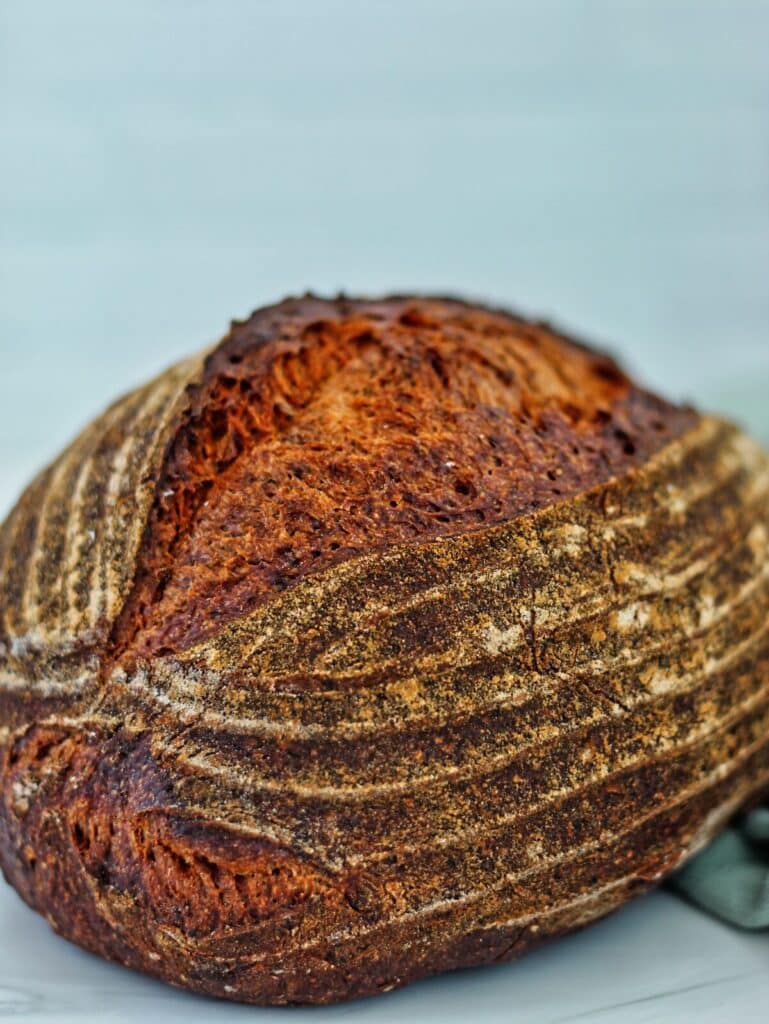
Gluten Free Sourdough Bread was originally posted on June 22, 2020 and has been updated with a modified recipe using a new sourdough starter, new pictures, and a new video.
Some of the items linked in this post are affiliate links, meaning, at no additional cost to you, if you click through and make a purchase, I will earn a small commission.
My husband has to remind me to slow down and take a breath when I find a new method of gluten free baking. Or a new (to me) ingredient that makes things so much better. My brain starts going a thousand miles a minute because I want to make ALL THE BREADS!!!
I have to learn to stop and focus on one thing at a time. But it's so hard because even though I wanted to update this earlier, I put it on a back burner. Not because I didn't have it nailed down, I wanted to try different variants and see how they would affect the final outcome. And I'm so glad I was diligent because there are so many new things I've learned about sourdough that are worth sharing.
Anywho, I know I'm a little late in revising this sourdough recipe to use my new(ish) sourdough starter method, but that's just how I am. I do NOT want to hurry things along just to get them on the blog because it's the right time. It's very important to me to test and retest recipes to make sure they're as perfect as I can get them before sharing them with you. But I promise, this one is well.worth.the.wait!
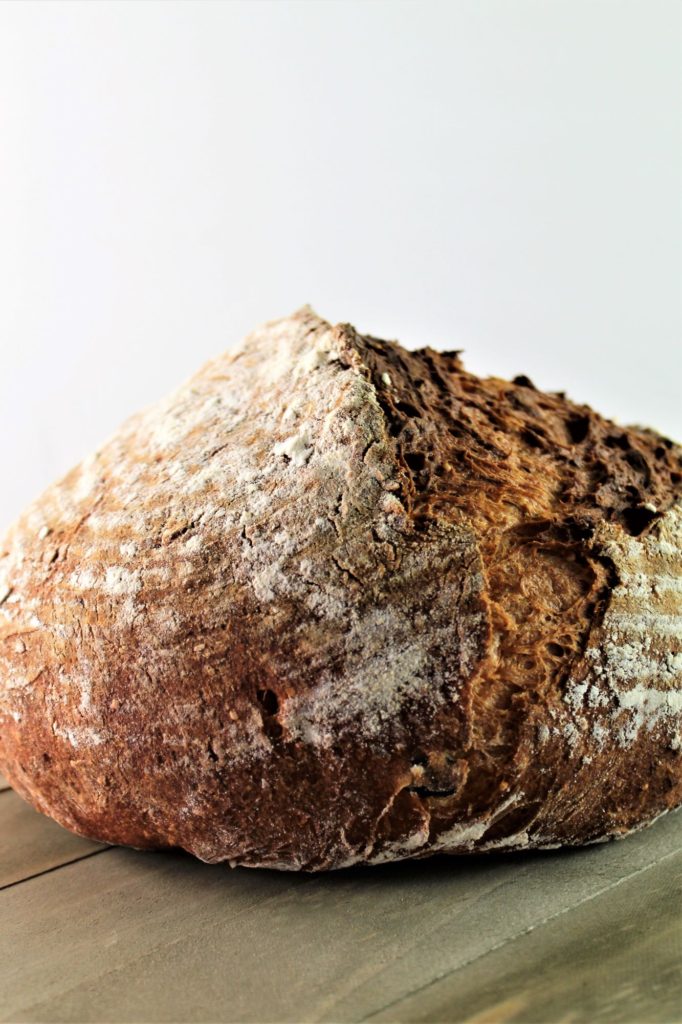
What IS Sourdough Bread?
Sourdough bread is a bread made without any commercial yeast. Instead, the yeast is substituted with a wild yeast and bacteria combined with flour and water, also known as a sourdough starter. You'll find all the details needed to start and maintain a gluten free sourdough starter in this post here.
When I think of sourdough bread, I'm transported to a local restaurant (Baker's Crust) eating a sandwich on their freshly baked sourdough without a care in the world. Slightly tangy, chewy textured, and a nice crisp crust, their sourdough was so good I could have eaten it plain. After taking my first bite of my homemade gf sourdough, I shut my eyes for a minute just to savor the flavor and the chew. It's like I was back in Baker's Crust eating that same bread again. Then I opened my eyes and looked again at the bread I had just made.
I was in an alternate reality because it sure looked just like the bread from that local restaurant, not at ALL like a gluten free version. And the texture was so spot on with what I remember! Isn't it crazy how memories of food we used to eat can stick so vividly in our minds, especially because we can no longer have those things?!?!
I promise you're going to love this bread, and any other breads you decide to make sourdough. Once I made one loaf, I was addicted and couldn't seem to stop baking ALL THE SOURDOUGH!!
ingredients needed to make the best GF sourdough of your life
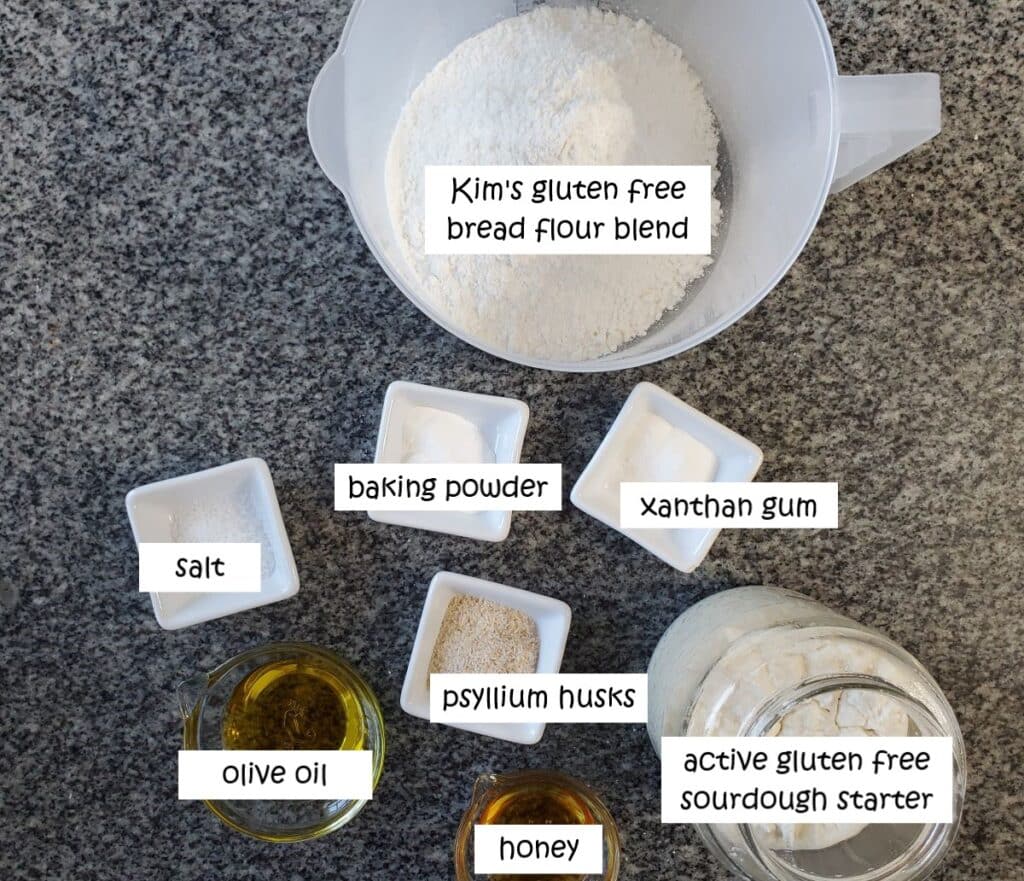
- Gluten free sourdough starter--you obviously will need a starter and my easy gluten free sourdough starter requires no daily feedings and no daily discard once it's established. What's more, it can hang out in the fridge until you're ready to feed and use it.
- Baking powder--you can leave it out and the bread will still be delicious. You just might not get quite as much oven spring. You can also use regular baking powder, but my preference is to use heat-activated baking powder (affiliate link) because you get maximum oven spring. More on that below.
- Psyllium husks--another optional ingredient, but it lends a better ability to shape the dough. Without it, you may have some trouble with stickiness.
helpful tools for getting started
- Digital kitchen scale -- this is the hill I will die on. The kitchen scale hill. Please, just do yourself a favor and buy a cheap kitchen scale and start using it. You will thank me profusely. The accuracy and ease is bar none.
- Stand mixer -- a great stand mixer is an investment, but it's one that will last a long, long time (mine is still kickin' after nearly 30 years!). A Danish dough whisk can be substituted with a little more elbow grease, but you'll get the best results with a stand mixer.
- Dutch oven -- until I tried it, I didn't know the advantage of using a Dutch oven. But once I tried it, I'll never go back. It holds in the steam for maximum oven spring. There are circumstances where a Dutch oven just won't do, though (think baguettes), in which case the second best option is a pizza steel, pizza stone, or overturned baking sheet set on your middle rack with a shallow heat-proof pan on the rack below this. Hot water is poured into the shallow pan, which creates steam for good oven spring.
- Bread lame -- it's not absolutely necessary, but a bread lame is a great tool for scoring your sourdough. I started scoring with a serrated knife, but I found I got better results with a lame.
- Banneton basket -- these little baskets are perfect for shaping and getting those beautiful lines on your finished bread (and they're fairly cheap), but another alternative is an high-temperature-oven-safe bowl, such as a Pyrex bowl, lined with a tea towel will also do.
Tips for Making Gluten Free Sourdough Bread
When first starting my venture into the gluten free sourdough world, I knew the best recipe to begin with was my gluten free artisan bread. It's easy enough to make and it already has a good crust and nice texture.
But the first thing I needed to do was research, research, research. I knew nothing about baking sourdough, gluten free or not! And once I understood a little more, I started experimenting. And here's a few things I've learned along the way:
- Gluten free sourdough bread isn't as involved as its gluten-filled counterpart. What I mean by this is there is a lot of stretching and folding the dough when making regular (gluten-filled) sourdough bread. That doesn't work for gluten free dough (there's not enough stretch). So the hands-on time is exactly the same as in any of my bread recipes (very minimal).
- Sourdough takes longer to rise. I usually let most of my dough bulk ferment for roughly 2 hours. When making sourdough, however, this may increase to 3-4 hours (or more). And still, it won't have as much bulk rise as its commercial yeast counterpart.
- Completely optional, but adding baking powder to the dough increases its oven spring. And specifically adding heat-activated baking powder (affiliate link) will allow the baking powder to lay dormant until the dough hits the hot temperature of the oven.
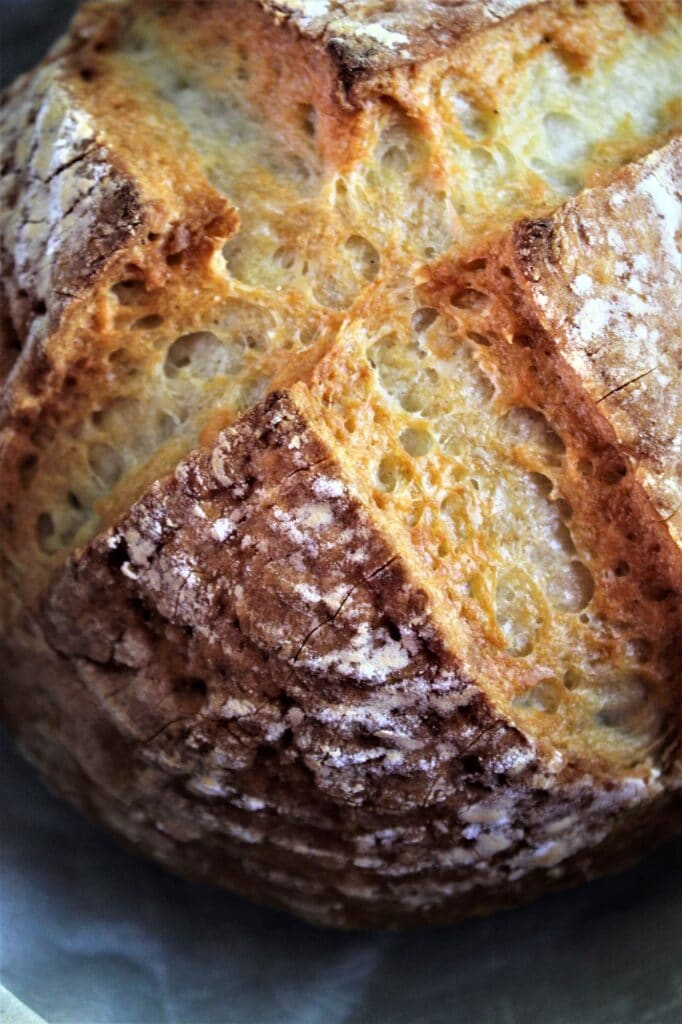
how to make sourdough
- If you haven't yet made your gluten free starter, go to my sourdough starter post and get that going. It takes at least 10 days (or longer, depending on the time of year/temperature). Feed your starter with 50 grams of whole grain flour and 50 grams of water. Stir and adjust with more water if necessary. Allow it to almost double in size (depending on the thickness, it may not completely double), which will take 8-10 hours on average.
- When your starter is ready, make the dough. Add all ingredients to the bowl of a stand mixer and mix on medium high for 5 minutes. Cover and proof for 3-4 hours, or until puffed. Refrigerate overnight.
- When ready to shape, knead dough on well-floured surface. Shape into boule or batard (or whatever shape your banneton basket is--if using). If not using a banneton, shape and place onto a baking sheet lined with parchment paper.
- Cover and let rise until almost doubled in size.
- Halfway through proofing, place a Dutch oven in your oven and preheat the oven to 500 degrees F.
- Carefully flip dough over onto a sheet of parchment and slash with a bread lame (affiliate link).
- Carefully lower shaped dough into hot Dutch oven with parchment and replace lid.
- Reduce heat to 450 degrees F and bake for 40 minutes with the lid on and 20 minutes with the lid off.
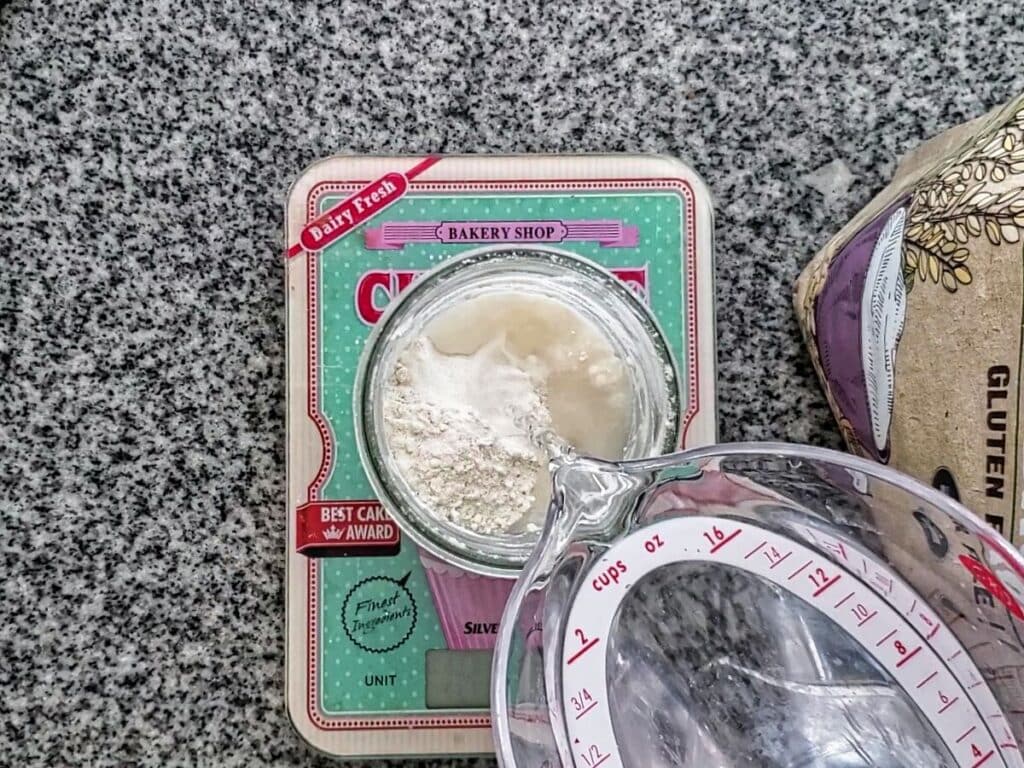
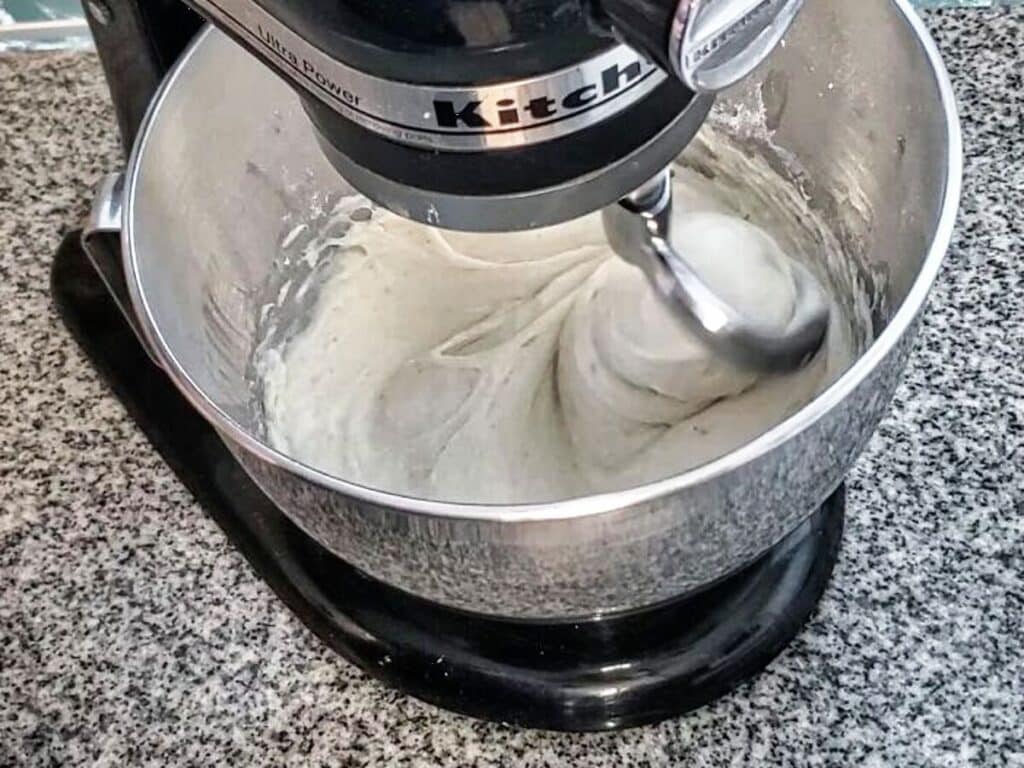
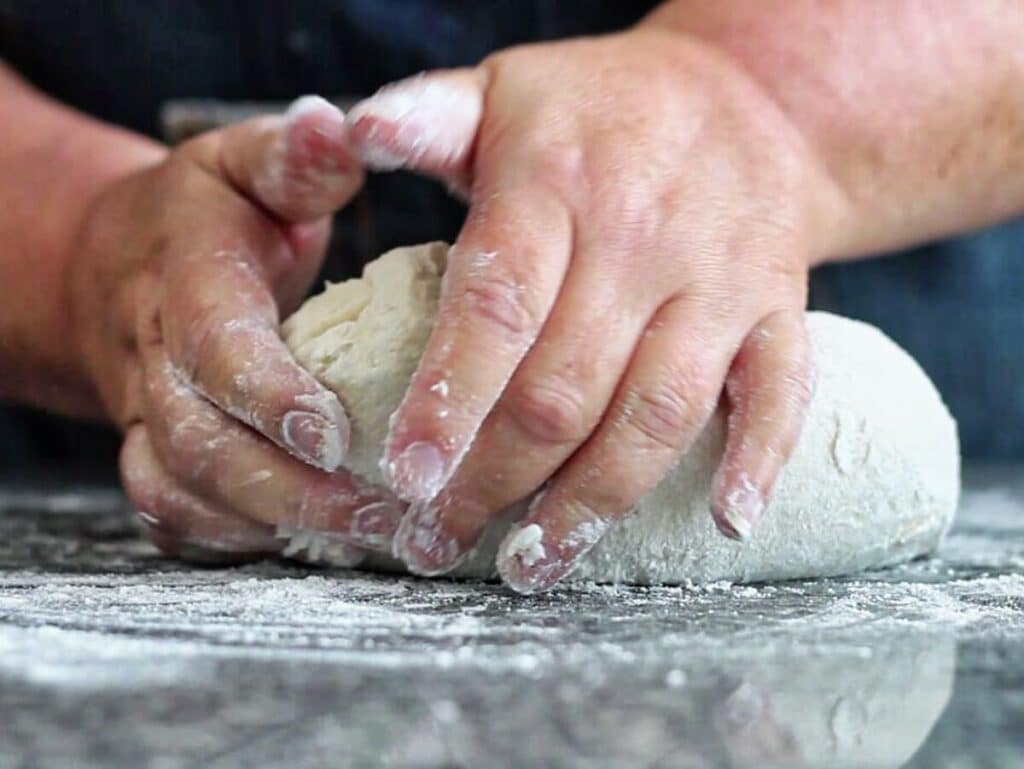
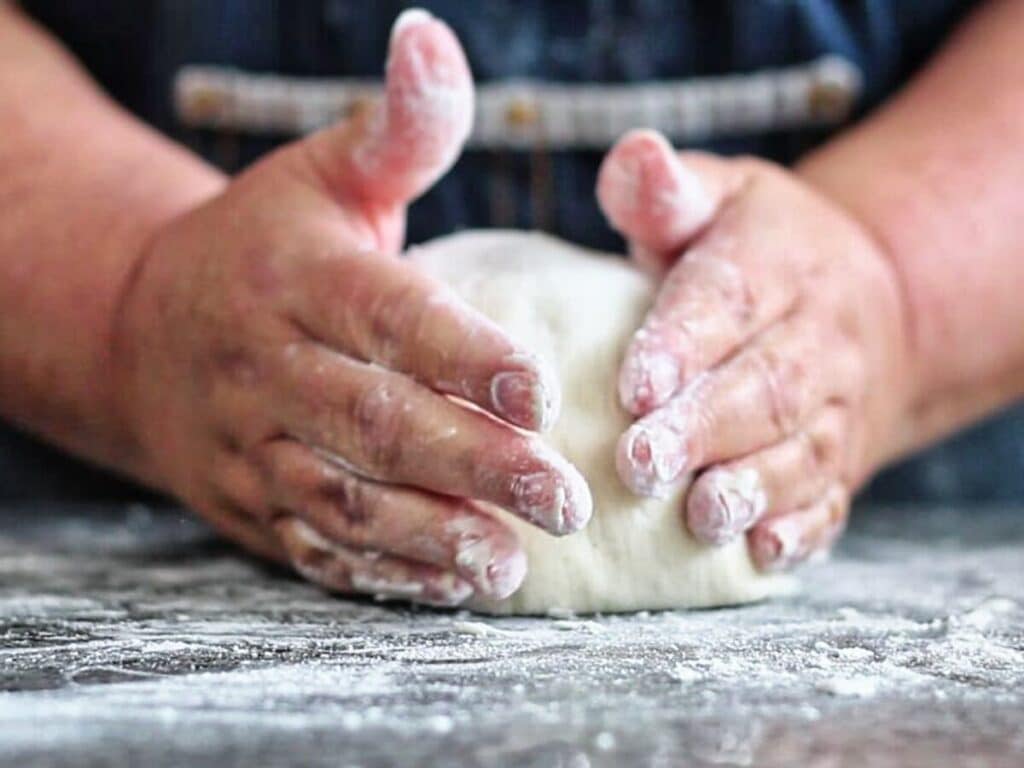
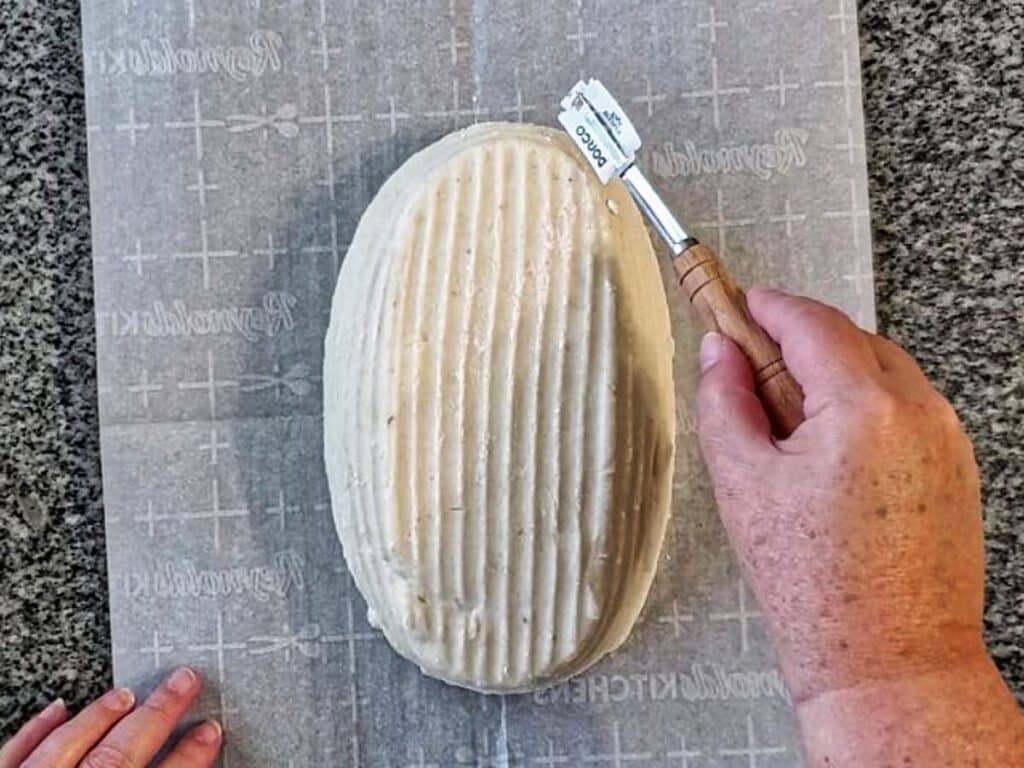
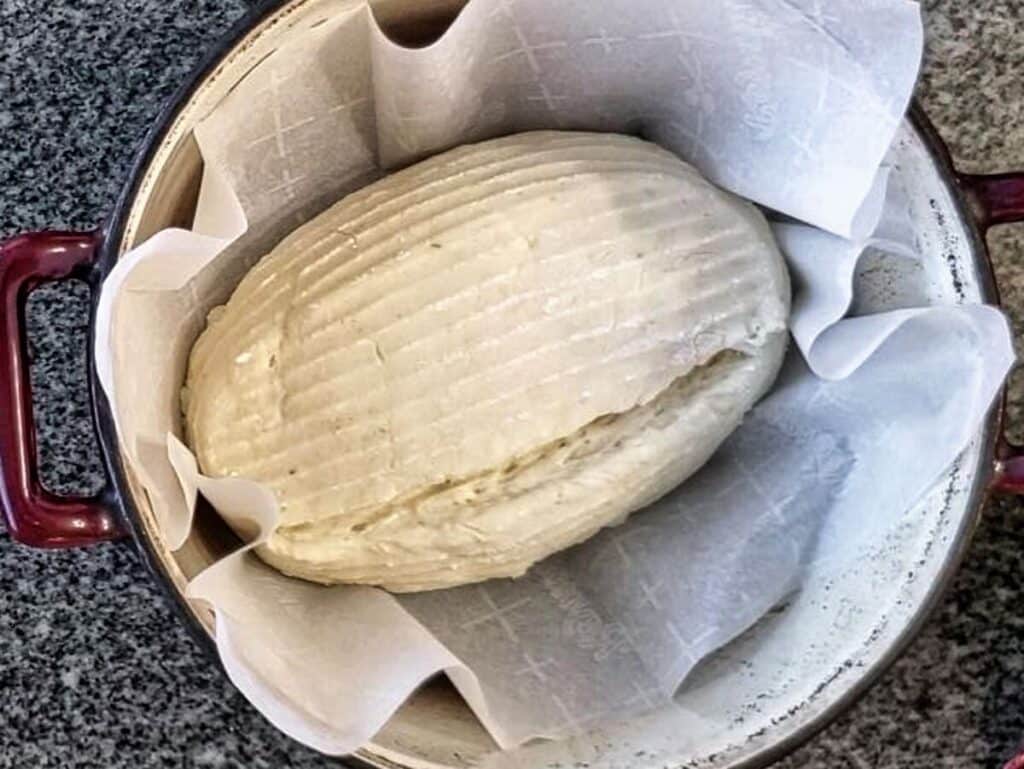
Rather Watch?
Timelines for Feeding Your Starter and Making Sourdough
There are a few different ways to make this bread that will fit into anyone's schedule. Pick the one that works best for you.
The Night Before Feeding
- Feed the starter directly from the fridge and replace the lid. Leave it on the counter all night long.
- In the morning, make your dough. Return the rest of the starter to the fridge until the next time you bake sourdough.
- Bulk ferment your dough for 3-4 hours, then refrigerate overnight.
- The next morning, shape dough, proof, and bake.
Morning Feeding
- Remove the starter from the fridge and allow it to warm up at room temperature before feeding it (a couple of hours).
- Feed your starter and allow it to nearly double in size, which can take up to 6-8 hours or more.
- In the evening, make your dough and return the rest of your starter to the fridge.
- Bulk ferment your dough for 3-4 hours, then refrigerate overnight.
- The next morning, shape dough, proof, and bake.
help! I fed my starter and now I have to leave
No worries. If you fed your starter and find that you unexpectedly have to go out, just put it in the fridge until you return. As long as the starter has been fed within 2 weeks, you can use it directly without needing to feed it again. However, if your starter has become too thin and inactive, this method will not work. That's why it's always best to err on the side of creating a thicker starter.
Why is Your Recipe in Grams and Not Cups?
When it comes to gluten free sourdough baking, or any baking for that matter, it is really essential to have the proper measurements for each ingredient. The only way to assure this is by weight and not volume. One person's cup measurement could be a little different than another person's. By weighing ingredients, every person will always get the same exact ingredient amounts, which makes for better baking overall and easier troubleshooting if something goes wrong.
To Use a Dutch Oven or NOT To Use a Dutch Oven
I had tried baking bread in a Dutch oven previously, but it never really got to the height it did when I used the hot water technique in a shallow pan (see my original gf artisan bread post). But for sourdough, I really wanted to try it.
I bought myself this (affiliate link) 5 quart fairly cheap Dutch oven and set out to bake a great loaf of gf sourdough. And it did NOT disappoint!!!!! I am completely sold on the Dutch oven method. I now use a larger 6-quart Dutch oven because I find it offers less chance to get burned. If you don't have a Dutch oven, don't fret. You can still bake wonderful gluten free sourdough using the shallow pan hot water technique.
To use this technique, simply place a baking steel or stone or even an overturned baking sheet on the middle rack of your oven and a heat-resistant shallow baking pan (I use an old broiler pan) on the rack below it. Preheat your oven with both items in the oven and when ready to bake, slide the shaped dough (on a sheet of parchment) onto the baking steel/stone/pan and pour one cup of hot water into the shallow pan underneath. Close the door, drop the temp to 450 as per recipe instructions, and continue baking for 60 minutes total.
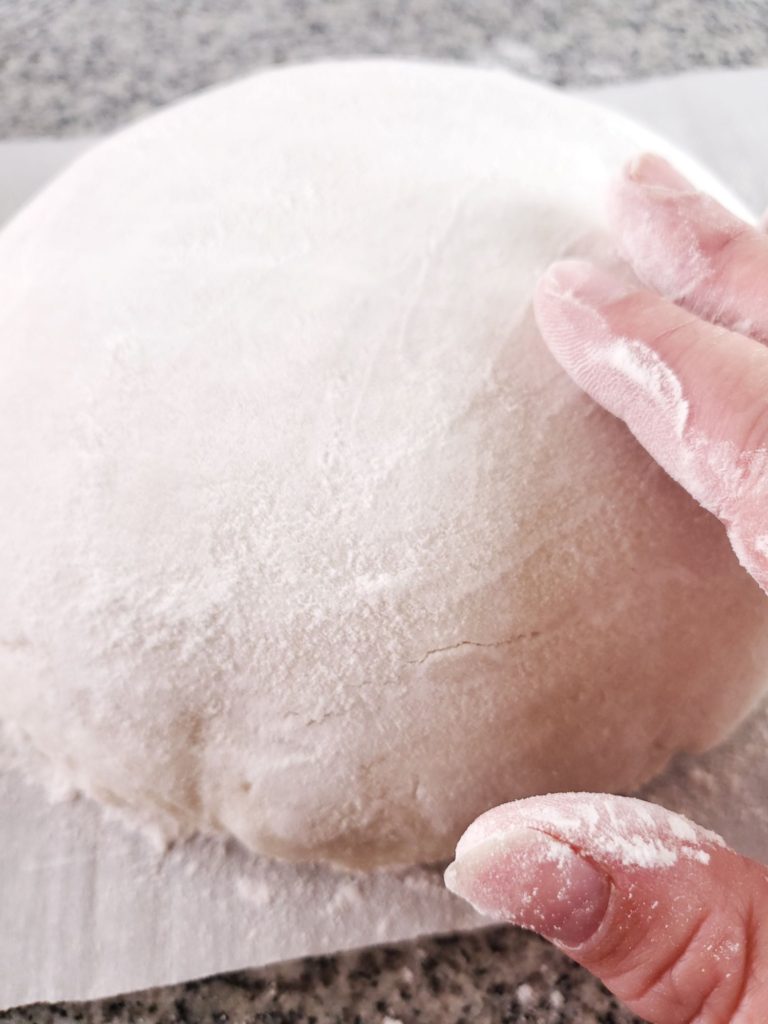
gluten free sourdough frequently asked questions
Sourdough bread is NOT gluten free, unless you make it with a gluten free starter and gluten free flours. While traditional sourdough breaks down some of the gluten in the bread, making it easier to digest, it is not gluten free and not safe for celiacs or anyone with a serious gluten intolerance.
There could be a few reasons, the top two being you didn't allow it to cool completely before cutting into it or you didn't bake it long enough. Most gluten free breads do best with a longer bake time than regular (wheat-based) breads.
Stash it in the fridge, where it will sit comfortably in limbo while awaiting your return. Guess what? As long as your starter is nice and strong, it will actually stay ready for up to TWO WEEKS!!
Not at all. Just pull it out, feed it with 30-50 grams of whole grain flour and 40-60 grams of water and it will revive right up. I once left mine in the back of my fridge for over 3 months and it was still alive and well after feeding!

How to Turn Any of My Breads into Sourdough
This gluten free artisan sourdough bread is just the beginning to a whole new gluten free world. There are many other breads that can be made using a sourdough starter instead of yeast with simple steps:
- Use 60 grams of gluten free sourdough starter as a replacement for the yeast in the recipe.
- Reduce the flour in the recipe by 30 grams and the liquid also by 30 grams. However, if adding anything else to the dough, such as nuts, seeds, etc, do not reduce the water content at all. I like to pre-soak my nuts and seeds overnight so they don't soak up much of the water in the dough. But I still leave the liquid content the same as some water will inevitably be lost.
- Add more time to bulk fermentation, as well as proofing. Sourdough always takes longer to rise than instant yeast.
- For more of an open crumb, add ¼ to ½ teaspoon of baking soda when kneading the dough before shaping (just make sure to knead it in well or your baked bread will have brown streaks in the interior). It's not conventional, but we can't always do the conventional thing when baking gluten free.
Can I Add Nuts or Seeds or Dried Fruit to My Sourdough?
Yes! Adding things like nuts, seeds, or dried fruit to bread is a great way to get extra nutrients and texture. I love a good seeded bread and sourdough is the ultimate seeded bread. See my Gluten Free Multigrain Seeded Bread recipe for ideas on how to do this (you will need to soak them prior to adding to the dough).
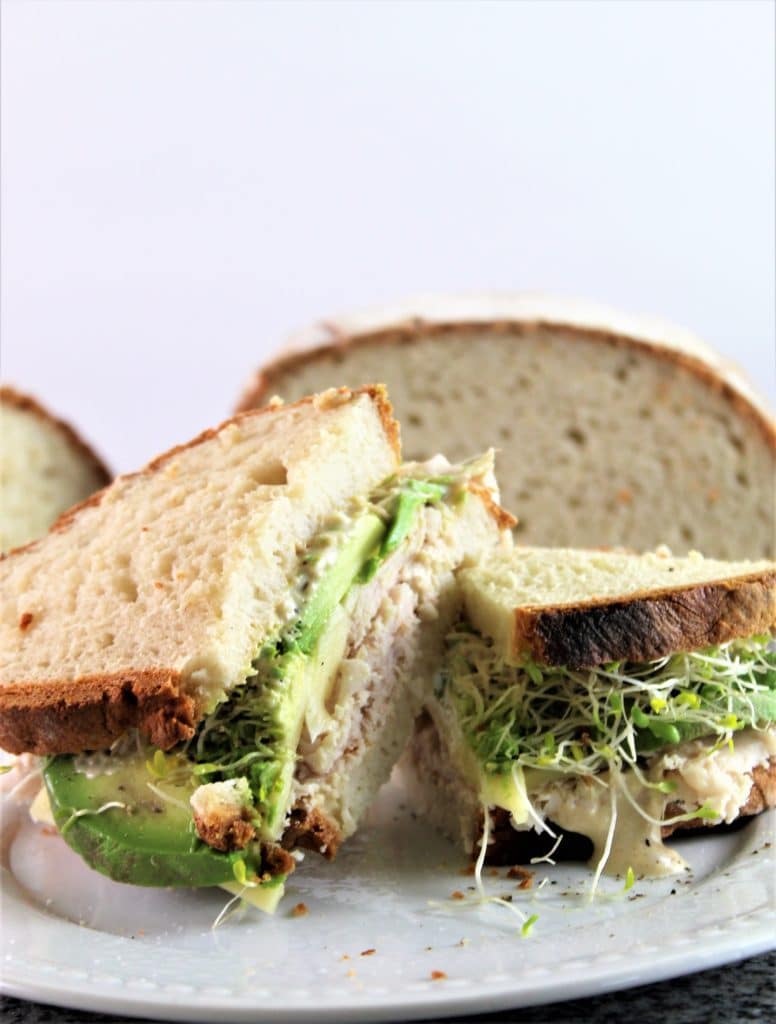
Hopefully your starter is bubbling away and you can now make your Perfect Gluten Free Sourdough Bread and be amazed that it's actually gluten free!
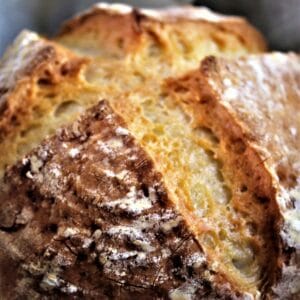
Best Ever Gluten Free Sourdough Bread
Ingredients
- 390 grams Kim's gluten free bread flour blend (another blend will not give the same results)
- 60 grams active gluten free sourdough starter (mature and ripe)**
- 5 grams whole psyllium husks or 1½ teaspoon psyllium husk powder (not required, but it will help with the stretch of the dough)
- 12 grams (2 tsp) kosher salt
- 10 grams (2 tsp) heat-activated baking powder (optional, but improves the crumb structure) (regular baking powder can also be used with less open crumb structure)
- 390 ml water
- 26 grams olive oil
- 21 grams honey
- ¼-½ teaspoon baking soda, added during kneading and shaping, if desired (optional) (do not use this if already using baking powder in the dough) (see notes)***
Instructions
Feed the Starter
- When ready to feed your starter, remove it from the fridge and feed it with 30-50g of a whole grain flour of choice (see notes*) and 30-50g of water. Stir and cover tightly. Leave on the counter until nearly doubled in size.
Make the Dough
- In the bowl of a stand mixer, add the water, olive oil, honey, gf bread flour blend, psyllium husks, baking powder (if using), salt, and active starter. Knead using the dough hook for 5 minutes on medium high. Alternatively, the dough can be mixed in a large bowl using a Danish dough whisk or similar, but you will need to mix very vigorously to get the proper texture.
- Cover the dough and allow it to rise in a warm, draft-free area until puffed, but not doubled in size, about 3-4 hours (sourdough always takes longer to rise). Place the puffed dough in the refrigerator overnight.
- The next day, remove the dough from the fridge and turn it out onto a surface well-floured with extra gf bread flour blend. If using baking soda, add ¼-½ teaspoon to top of dough and begin kneading dough until smooth. (Don't be afraid to add enough flour to shape the dough into a smooth shape).
- Form into a round and turn over into a floured banneton basket or in a floured tea towel-lined bowl. Cover and allow it to rise until dough reaches the top of the banneton or bowl, anywhere from 2-6 hours (this time varies because of temperature differences, humidity, etc).
- Towards the end of the rising time, place a Dutch oven with lid (or baking steel or stone and shallow pan) into the oven and preheat it to 500° F for 30 minutes.
- When the dough has finished rising, carefully flip it out onto a sheet of parchment paper and slash (score) it with a lame or sharp serrated knife. Open the oven door, carefully place the loaf in the Dutch oven, parchment and all, and replace the lid. Alternatively, slide the loaf, parchment and all, onto a baking steel or stone and pour one cup of hot water into the shallow pan. Immediately close the oven door and drop the temperature to 450° F. Bake the bread for 40 minutes. If using a Dutch oven, remove the cover and continue to bake for another 20 minutes. If using a baking steel or stone, bake the bread for the full 60 minutes.
- Remove the bread from the oven and allow to cool before slicing.



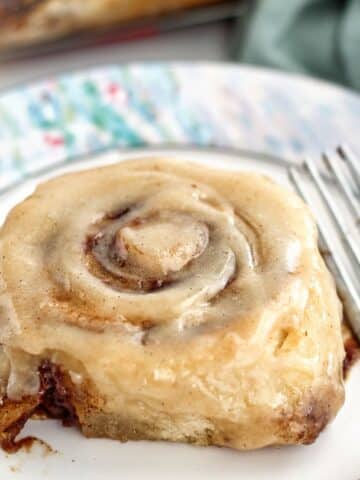

Alana Ry
Hi Kim!
Quick question…. But before I ask THANK YOU ☺️
I love your site, channel and all your thorough instructions!
Every time I make something, I wish I could give you a hug 🤗!
Okay, I’m just getting started on making my own bread!
Started with regular, now moving on to sourdough!
Do I need to use a banneton?… is there an alternative to a banneton?
Thanks and 😍
Melissa M Thornton
Thanks for the recipe! My starter is growing now, bubbly at only 2 days. But it was next to sauerkraut so I am not surprised. I make a TON of sourdough bread for my family and I occasionally teach classes.
There is a local allergen free vegan restaurant that wants me to teach a class to make Gluten Free Sourdough, your recipe is the first one I found (I have tried one a while ago but it was terrible). My issue is the whey protein. Have you ever tried Beef Gelatin? The cost and the fact that its dairy is the issue. I see you offer substitutes but have you tried any out and were successful? And just in case you were curious I did the math on this bread and its about $5-$6 food cost per loaf! Ouch! Still trying it though!
Connie
I tried again. The starter was the best it has ever been but loaf is not doubling in size. I put it in small bathroom with space heater yo warm the room. It has b e en 13 hours.it rose a little but definitely not double. Should I bake it as is or can I punch it down and do something else to get it to rise more?
Lauren
Hi Kim!
This recipe has given me pretty good results. I am following your recipe exact except for using hemp protein instead of whey. I first started using brown rice flour instead of white rice; and then I switched over to white rice as stated in your recipe. I used a brown rice starter. They both worked great, but the white rice bread is dark and brown almost exact color of the bread when using brown rice. I am trying to achieve a light white bread similar to your bread. Do you have any ideas of what I may be doing wrong?
Thank you
Kim
I'm guessing it's the hemp protein. It's been known to cause color changes.
barbara H Fraley
I know not to use metal when feeding my starter. My question is - when putting my sourdough recipe together, can I use my stand mixers stainless bowl and dough hook or will that kill the dough?
Kim
I actually use metal with no problems (read through the post about that). You can definitely use the stainless steel mixing bowls as well.
Connie
How do you know if dough is puffed? My house and kitchen tend to be on cold side. I put dough in glass bread pan on heated matt for about 5 hours.
I'm not good at kneading and my hands get sore, and dough not smooth like video.. is there an alternative for kneading?
Connie
I made this recipe a week ago for my daughter who has Crohns Disease. I baked it on a Tuesday evening. She ate the last of it on Friday morning, begging for more. She said it was perfect. There is hope..lolC
Kim
Oh, YAY!!!! I'm so happy that your daughter enjoyed it (AND that she said it was perfect!). What did you end up doing about the kneading?
Connie
I used dough hook on kitchen aid. I'm making another loaf and recently bought Reliaheat mat. It has been 6 hours on kitchen counter and nothing happening. How long should it take to double in size?
Kim
Depending on the room temperature, it can sometimes take upwards of 8-10 hours to proof. Don't rush it. Sourdough always takes longer to proof than regular dough, and so does gluten free.
Robin
The recipe on your video says 6 g salt when it looks like it's 12 listed here ( when I did the 6 it wasn't salted enough). Just wanted to let you know if you didn't...you probably do though. Thank you, btw, you're amazing!!
Kim
Thank you so much, Robin! Yes, it's supposed to be 12g. I apologize for that error in the video. Unfortunately, I can't change anything in the video once it's live, but if there's ever a question, always go by the written recipe here on the blog 🥰
Connie
I just received the Reliant Raisenne. I at stage 2 in making dough. I have dough in a glass bowl on matt for 3-4 hours befo Is this correct?
Dilyana
Made my sourdough starter using your recipe, but using chickpea flour. Then tested the bread once with some generic breadmix and did not turn well - on the next day was almost impossible to slice.
Today I made it with your bread mix and turned out perfectly! Thanks to much for the great recipe!
Kim
That's awesome!!
Nancy Schmidt
Hello! I’m waiting for my starter to ripen, and looking at proofing bowls. However, I’m not sure what size I need to buy. Should I buy 6”? 8”, 9”, 10”?…there seem to be a lot of options and I can’t find an answer in your recipe.
I’m looking forward to trying this recipe, as I’ve yet to find a good gluten-free sourdough bread.
Thanks!
Kim
The oval one I use is 10 inches, but the round one I use is 8, so they can vary.
Nancy Schmidt
Thank you so much!! I’ll be trying this recipe in a few days and I’ll let you know how it turns out.
Tom
Hi Kim,
My girlfriend is gluten sensitive and found your recipe (and youtube video). We are excited to give it a try!
Can you make a variant for usage with King Arthur's Measure for Measure? I think this means we shouldn't have to add xanthan gum?
Let me know!
Kim
I'm sorry. I only use my own flour blends, especially for any of my bread recipes, because none of the flour blends on the market gave me the results that I get when using my own blend.
Sarah
Hi! I have a question (please please help if you have time), but first would like to say how amazing this bread tastes! My aunt gave me some gf started because I’d let mine die looong ago. I’d given up on finding a gf sourdough that actually tastes good. I’ve been gf since I was a kid (the 90’s were not good for celiacs), and the thing I still miss the most is a good sourdough.
Anyway, thank you! It’s delicious! My very selective (picky?) kid even likes it!
My question though: how to get the crust less, well, crusty? My kids have a hard time with a hard crust and I have dental work that bends easily. I’ve tried letting it cool wrapped in a towel. Any other suggestions? Could I leave the lid on the whole bake time? Longer, lower bake time (but maybe that would ruin the beautiful oven spring).
I’d love any advice or ideas you have. And I can’t wait to try more of your recipes! I’m excited to bake for the first time in years!
Kim
Awe, that's awesome that you're excited about baking again!!! I know how that goes and I've been there.
I understand the crust issue. My husband doesn't like the sourdough crust either. A couple of things you could try, along with the towel wrap, is to leave it in the Dutch oven like you said. You could also substitute the water in the dough with milk, which will give it a softer crust. You could also try to bake it in a loaf pan, but at the moment I don't know the adjustments you would need to make for it to be baked in the loaf pan. I'm currently testing a sourdough sandwich loaf that is softer, so keep an eye out for that. It's still in the works, but hopefully I'll get it perfected and on the blog before too long.
Hope this helps!
Sarah
Thank you so much! I’ll try using milk next time! And I’m looking forward to your sourdough sandwich loaf!
HD
Any new updates on using a loaf pan? This is my first GF Sourdough but I've baked a non-GF previously with no problem in a loaf pan.
Murat
Hi Kim,
I double the ingredients because my Dutch oven is too big. Preheated the
Dutch oven to 500F then I reduced to 450F then I put the dough in. I did 40min closed Dutch oven then 25min open Dutch oven.
It was good crust and rise but inside is little doughy.
Kim
It's because you doubled the ingredients. My Dutch oven is also large and the bread has no problems using the original amount.
Laura
Hi Kim, so I ended up with this same gummy/doughy texture without doubling the recipe. The only variation is that I (for lack of a better option), had to use pea protein powder. I did the baking soda during kneading, and everything seemed to be going well, bottom sounded hollow when I pulled it out of my Dutch oven and tapped, tastes great (kudos btw), but gummy. Any suggestions?
Kim
I would try it again and add another 10 minutes to the bake time. Gumminess is almost always due to underbaking. Also, make sure to let it cool completely before slicing.
Colleen Skeffington
Hi Kim, absolute perfection. Your recipe is so easy to follow, I've watched numerous videos on making Gluten Free breads and sour dough bread. So far yours is the very best.
My question is what can I substitute for the whey protein powder? I tried a clean protein powder and the bread is amazing, but we can taste the protein powder. Crumb texture, squishy-ness, all great.
Just looking for it to taste more like sour dough bread.
Thank you.
savanna
Hi Kim,
Ill be making your recipe this weekend and would like to use a starter my friend has made for me. I am new to sourdough so not totally sure but do i treat it the same way as if it was yours? would i feed it the night before etc?
Kim
Yes, I assume you would treat it the same as mine and proceed with the recipe as instructed. Let me know how it works!
Savanna
I just pulled my loaf out of the oven and OH MY GOODNESS. It is GORGEOUS!! I made your gluten free flour blend, and followed everything to the T. TRUST THE PROCESS PEOPLE! I did accidentally leave it on the counter for 8 hours instead of 4 ( I turned my alarm off in my sleep ) but it still turned out perfect. After the fridge set I did leave it on the counter for a few hours and noticed not that much difference so I put it in the 170 oven for a few hours. I wish I can post a picture. This was my first time using sourdough, let alone in a gluten free bread recipe! I’ll be trying all your recipes now!
Kim
Awe, yay!!!!! So glad it turned out well for you!!!
Jennifer
Hi Kim! I was so excited to find this gluten free starter recipe!! Thank you for sharing it. I followed the recipe to a T and now I'd like to bake some bread. However, my starter is not doubling in size. It has been fed, lightly covered and on my counter for 2 days now and has risen a bit but definitely not doubled. Help?!
Kim
It's not going to do much in 2 days. You need to give it at least a week to ten days (or longer, especially in cold weather) for it to fully develop.
Olivia
Kim! Thank you so much for this recipe! I’ve made it half a dozen times and love the taste. That said, do you have any tips for baking at altitude? I live in Denver and despite adding baking soda and a bit more water my crumb is always very dense. Thank you!
Kim
I am at sea level so I don't know much about baking at high altitude, but here is a post that some of my readers have found very helpful who are baking at high altitude. Hope this helps! https://www.kingarthurbaking.com/learn/resources/high-altitude-baking
Oleana
Hi Kim. Could you please clarify how much starter in grams do you use for your sour dough bread recipe? The way I read it is that you take ALL your starter from the fridge, feed it and use it ALL. Isn't it too much though? Then there would be none left for next time:) Thank you so much for answering!
Oleana
Oh, nevermind Kim, I found it! 60gr. Cheers!
Hail
Is the initial dough supposed to be so wet? I’m new to gluten free baking, and I’ve read the recipe/ingredient list a hundred times trying to see if I mixed up the ratios. But the flour (in grams) and the water (in ml) are the same? It seems like such a high hydration but I’m so not used to gluten free so I don’t know if it will come together more as it sits/rises/ferments? It’s almost like a cornbread batter consistency right now that I’ve added all the ingredients. I’m just wondering if I’m missing something.
Thanks!
mel
If it's of any comfort, I'm making this for the first time, and I followed the instructions to a T, and my dough is quite wet as well! Not like how it looks in the video. I came here looking for advice haha. I think I'm going to let it proof for longer if I don't find a solid answer. You're not crazy!
Alissa
I am having the same issue too! Like unworkable sticky. Did you ever find a solution?
Mine looks nothing like the dough in her video 🙁
Marylou
I'm having the same issue. Kim said to not be afraid to add enough GF flour to be able to knead it, so I used almost all of the rest of her bread flour mix to get it smooth and not so sticky. It has barely risen after 4 hours, so I'm hoping it will be ready to bake in a few more.
Kim
Sourdough always takes longer to rise, even non gluten free, and with colder weather it could take extra long. Try to go more by how it looks than the actual time. It's been kind of cold here and when I made sourdough the other day, I had to leave it sit on the counter overnight for it to rise. So I put it in the fridge for a few hours (3-4) and was able to shape it and bake it the next day. I had to put it in a warm oven (turned on to 160 F just to warm it and then turned off) for a few hours before it was ready to bake after that second proof. It is very normal for it to take a long time, especially in colder months.
Allison
This is my first attempt at sourdough and I also have an extremely sticky mess. I followed the recipe using my scale, let it proof on the counter for 4+ hours before putting it in the fridge overnight. This morning, when I tried to knead it, I couldn’t because it was so sticky and wet. I added all the rest of the flour from the initial blend recipe and it was still extremely sticky. I can’t form it into a ball. I’m afraid to put it in my banneton for fear of the mess it will make. I put in back in my mixing bowl and used the dough hook for another 5ish minutes. It’s now resting in my mixing bowl and I’m not sure what to do next. Did you end up baking yours? Did it turn out at all?
Kim
A few questions: what type of rice flour did you use in the flour blend (or did you use a store bought flour blend)? For the bulk fermentation (the first rise), did it actually rise or did you just put it in the fridge after 4+ hours? What was the consistency of your starter?
If any of the above are off, you will not get the same results as me. If you use a store bought blend, it will not work. If you use a rice flour other than the ones I recommend (on the flour blend page), you will have a very sticky mess. If you do not allow the dough to proof completely on the bulk ferment, you will have a sticky mess. In the colder months, this could take upwards of 8 hours or more. I often leave mine on my counter to proof overnight in the colder months. If your starter is too thin, you will have a very sticky mess.
If you did all of the above correctly and are still having problems, please let me know and maybe I can troubleshoot a little further for you. I hope this helps 🤞🤗
Kelly
I keep adding more flour to look like the video. I had to add a lot. Now I hope it works. 🤞🏼
Kim
Did you use my flour blend or substitute anything within the blend?
Becky
Hi Kim, thanks for all of your wonderful recipes and flour blends! I made my first sourdough load today following your recipe and the crust is so very dark I'm wondering if there is a way to avoid that? Oven temp checked out good, and I used an enameled dutch oven. Either way, I can't wait for it to cool so that I can slice and taste it!!!
Angelica
I am super excited to start my sour dough starter (day 2 ) I actually thought one didn't exist for celiac disease so when researching I literally was so happy. I have SO many questions about it while researching the best I could.
1. what flours are best that is used for gluten free sour dough that gives a very close texture to gluten containing sourdough
2. how do I achieve a nice crunch ?
3. I want to try making my bread in a cast iron bread pan I saw do you think this will come out good
4. since I am on day 2 I did not discard was I supposed to discard yet I have read day 3 is when it usually begins
5. how do I avoid a very sour taste to the starter I know that can sometimes happen
6. what brand of husk is your absolute favorite
7. how do I avoid a super sticky starter when I am ready to make your bread recipe
marianne hurley
I have made and loved the first version of this bread - even though I omit the psyllium because my husband is very allergic to it!I just found version 2.0 and will be baking it for the first time today.
My question is about the crust. I do not like a hard, crispy crust. What do you recommend to produce a crust that is only slightly crisp?
Kim
I actually find by either covering the loaf with a tea towel or placing it under foil when it comes out of the oven will soften the crust perfectly.
marianne hurley
Thank-you, I'll try that next. I thought about brushing it with melted butter when it comes out like I used to do with my regular gluten loaves.
Tiffanny
Is the psyllium husk that you use and that is pictured on your recipe ingredients whole psyllium husks or the husk powder? My container states "whole psyllium husk" and looks like yours but it is ground small enough that it could be considered a powder. I ask because I just started the recipe and after 5 minutes with the dough hook, I found multiple balls of what appears to primarily be psyllium husk. So, I won't be baking this until tomorrow but if it doesn't turn out and I do some trouble shooting, I thought that may be a place to start. I'm wondering if the dough hook isn't enough to mix the ingredients well and if I should start with the ceramic beater, mix until everything is combined and then put on the dough hook. I'm very excited by the recipe . Thank you!